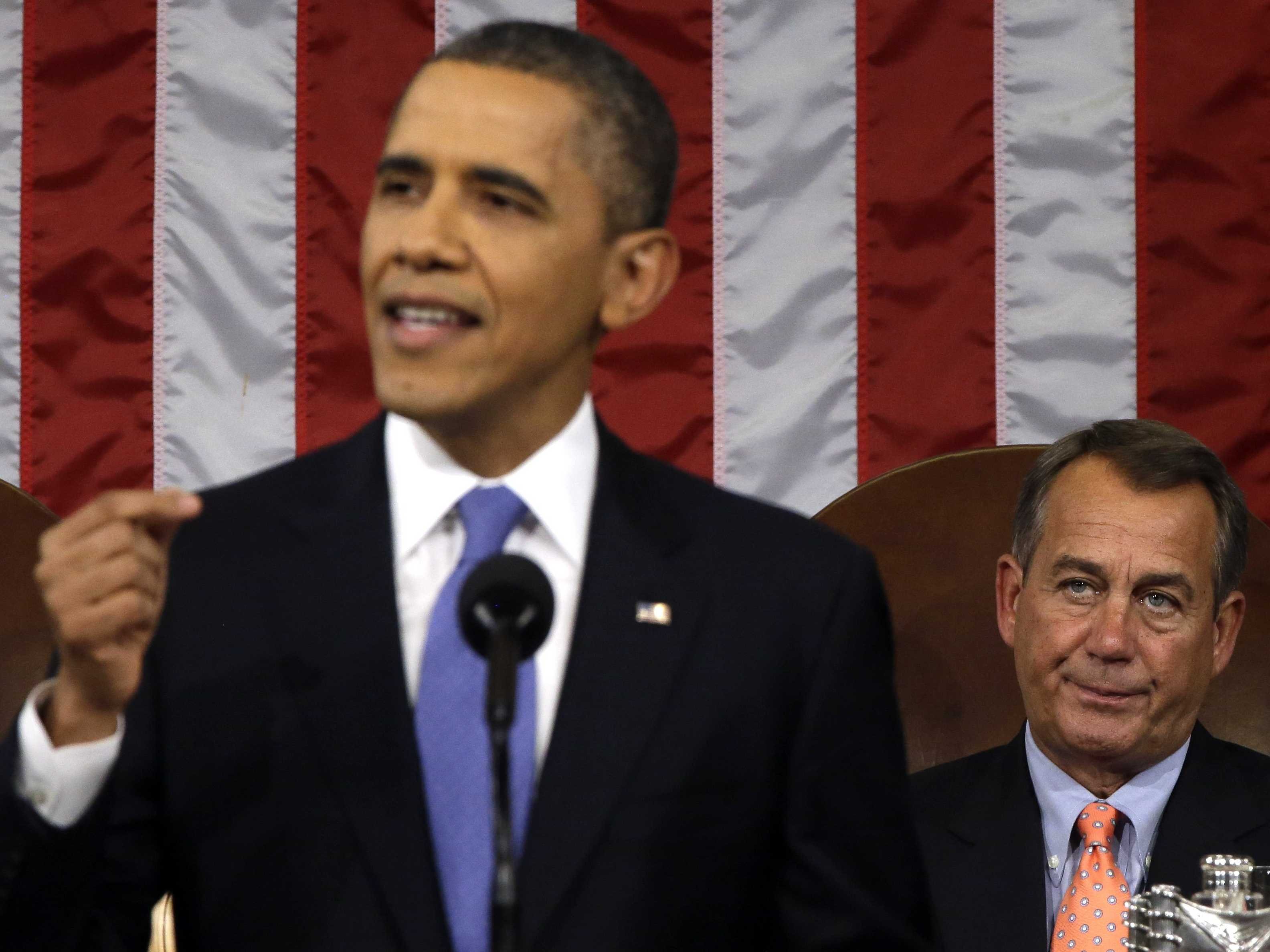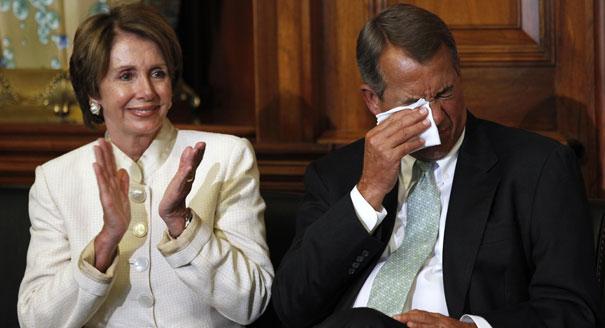It was music to the ears of classical aficionados worldwide when President Barack Obama became the first American president to officially call for a national commitment to take exposition repeats in last week’s State of the Union speech . Obama brought repeat supporters to their feet with an oratorical flourish culminating in the statement that “I don’t care if it’s a crescendo, or a dimenuendo, a sharp or a flat- I want this to be an America that respects all forms of musical notation equally, and from 2013, that’s going to include a nationwide respect for exposition repeats! If a theme is worth hearing once- it’s worth hearing twice! If a theme is worth hearing once- it’s worth hearing twice!”
Although exposition repeats exist in at least 10 per cent of all classical movements, their presence has often been overlooked, downplayed or demeaned in the concert hall compared to other forms of musical notation such as pitches and rhythms.

“America is changing, and I want my daughters to grow up in a world where it is okay to take the exposition repeat even in the first movement of Rachmaninoff 2”
Wilfred Pennyschnauzer, deputy vice president of the West Poughkeepsie Campaign for Equality for Exposition Repeats said he wept when Obama uttered the fateful words on Tuesday evening. “I gotta tell you,” he said, his voice still choked with emotion, “we’ve all known there were enlightened places where you could take an exposition repeat without too much fear of grumbling from tired violinists or impatient society ladies, but you shouldn’t have to go to New York or San Francisco to hear the Eroica with the exposition repeat. Just to hear the President of the United States say to the nation, and the whole world, that all exposition repeats can and should be taken in every town and village- well that meant a whole lot. It’s good to hear the President saying we should respect all kinds of music notation- not just the pitches and the loud dynamics.”
A number Beltway pundits, however, sounded a cynical note after the broadcast, noting that as recently as his first presidential campaign, Obama had described the exposition of a Sonata-Allegro movement as “a sacred union between one set of musical ideas and one run-through by the performers.”
“I don’t think this is real leadership,” said Wagner von Hanslick from the left-leaning think tank, the American Musicological Institute, “as much as it is Obama following a demographic shift in the US population. Exposition repeats are no longer considered a tedious necessity- they’re supported by over 64% of the American people. Obama is just recognizing that the national consensus has changed, and he has to change with it if he wants to stay popular.”
Indeed, Obama’s position on exposition repeats was reported by sources close to the president as “evolving” for much of his first term. Much to the dismay of exposition repeat rights activists who had hoped for early decisive action, presidential pollsters had floated a number of trial balloons in 2009 -10 exploring public reactions to more modest policies that would allow for performers to take exposition repeats on a case-by-case basis, as long as “it doesn’t make the concert too damn long,” without specifically acknowledging the repeat sign as a form or music notation worthy of equal consideration as accidentals, accents and tempo markings.
Even as recently as December, Obama was reported to be hedging on whether he would include plans for the official recognition of exposition repeats in his second term. Many Washington insiders attribute the final public shift in policy to Vice President Joseph Biden’s December 21s appearance on the Sunday morning program, “Musicology Today,” in which the famously loquacious VP said bluntly “For Pete’s sake, guys- can’t we just accept that exposition repeats are an intrinsic part of a well balanced Sonata-Allegro structure? Just take the damned repeats for godsake!”

Vice President Joe Biden; “For godssake- it’s not freakin’ rocket science: Brahms writes a repeat, just take the damn repeat!”
Republican leaders expressed dismay and scepticism at the President’s embrace of a form of musical notation long scorned by the American musical establishment. “Job creators are busy people, and making them sit through a repeat of the exposition of a Brahms symphony or a Schubert sonata is just going keep them from having the time they need to create jobs,” said Senator Rand Paul of Kentucky.

“Exposition repeats are for socialists. Listening to all those themes a second time gives me dry mouth.”
Maro Rubio, delivering the Republican response to the State of the Union addres, also felt that insisting on universal implementation of exposition repeats was “un-American.”
“America is a free country,” he said between sips of bottled water. “We think concert creators should be free to pick and choose which bits of Beethoven’s genius they give a shit about, and ignore what doesn’t appeal to them. Recognizing that the Mahler who wrote the Alma theme in the Sixth Symphony is the same unique creative artist that wrote the exposition repeat which follows it a few bars later is the first step on the road to Socialism. First we have to take the repeats, then we follow the symphony with an encore performance of The Internationale. If people want to hear exposition repeats, they can move to Finland or some other communist hellhole.”

Speaker John Boehner was reduced to tears on Tuesday at the thought of having to hear the exposition of Mozart’s Jupiter twice.
House Speaker, John Boehner of Ohio said that he wouldn’t consider allowing exposition repeats without pre-agreed cuts. “Long concerts are already bloating our national attention deficit. If the President wants to repeat the expositions of Sonata-allegro movements in core repertoire, he’s going to have to come up with compensating cuts in the other movements”
However, long-time Obama confidant and senior political advisor David Plouffe predicted swift passage of the “American Exposition Respect Act.” “Republicans are looking at the polls and seeing the same numbers Obama did- fighting this thing is a loser, and if we pass it, it should momentarily placate our liberal base, so the President can go back to doing what he does best- murdering people with drone aircraft, protecting the financial interests of the Wall Street elite and destroying the lives of governmental whistle-blowers. The Republicans want the government and the President to focus on those things as badly as we do.”
Ah, but what of development section repeats? Time for a third party! Great post!
What about the exposition repeat in the last movement of Beethoven’s 5th? It’s a serious waste of time to cover that ground again. It wastes the time of both the audience and the orchestra. Perhaps that might be one of the “pre-agreed” cuts in Bohener’s proposition, and one of the few (very few) ways that we might share common ground. I would also lobby for the elimination of the second repeat in the last movement of Beethoven’s Opus 135. But my score says “Si repete la seconda parte al suo piacere,” and “piacere” is akin to the pursuit of happiness, which is also related to “life” and “liberty.” I fear I would need to yield the rest of my time to a legal scholar.
I’m part of the 64%. Finally something I can agree with President Obama about!